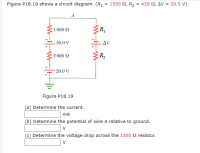
College Physics
11th Edition
ISBN: 9781305952300
Author: Raymond A. Serway, Chris Vuille
Publisher: Cengage Learning
expand_more
expand_more
format_list_bulleted
Question
Figure P18.19 shows a circuit diagram. (R1 = 1550 , R2 = 430 , ΔV = 20.5 V)
(a) Determine the current.
(b) Determine the potential of wire A relative to ground.
(c) Determine the voltage drop across the 1550 resistor.

Transcribed Image Text:A
1 000 Ω
R
30.0 V
Δν
: 2 000 Ω
R
20.0 V
Expert Solution
This question has been solved!
Explore an expertly crafted, step-by-step solution for a thorough understanding of key concepts.
This is a popular solution
Trending nowThis is a popular solution!
Step by stepSolved in 5 steps with 4 images

Knowledge Booster
Learn more about
Need a deep-dive on the concept behind this application? Look no further. Learn more about this topic, physics and related others by exploring similar questions and additional content below.Similar questions
- In the circuit pictured, the resistors have values of R1 = 125 Ω, R2 = 120 Ω, and R3 = 148 Ω, and the battery has an emf ε = 271 V. A) Write an expression for the current through the battery. B)In amperes, how much current ibatt goes through the battery? C)Write an expression for the current through resistor 2. D) In amperes, whatis the current i2 through resistor R2?arrow_forwardE10P2arrow_forwardAssume the capacitor in the circuit is initially uncharged. A) Calculate the current through each resistor right after the circuit is connected. B) Now let’s say, the circuit has been connected and left alone for a long time.Calculate the charge on the capacitor plate.arrow_forward
- A heart pacemaker fires exactly 71 times a minute. Each time it fires, a 19.0 nF capacitor is charged by a battery in series with a resistor to 0.582 of its full voltage. What is the value of the resistance R? R =arrow_forwardIn the figure the ideal batteries have emfs E1 = 4,89 V and E2 = 10.2 V, the resistances are each 2.41 Q, and the potential is defined to be zero at the grounded point of the circuit. What are potentials (a)V1 and (b)V2 at the indicated points? R. R3 Units (a) Number Units (b) Numberarrow_forwardE2 R1 R2 2. Find the charge on the capacitor after the switch has been left open for some time, then closed for some period of time. We can assume that C = 2 µF, with batteries of values E1 R2 = 0.25 N. 2V and E2 =1V, and resistor values R1 = 0.5 N and Sarrow_forward
- The drawing shows three different resistors in two different circuits. The battery has voltage of V = 26V, and the resistors have resistances of R one = 50.0, 2 = 25.0 and 3 = 10.0 determine the current through the voltage across each resistor. For circuit you’ll have six parts to the answer: l1,l2,l3, V1, V2, V3. For circut B you will have 6 parts to the answer: l1, l2, l3, V1, V2, V3. arrow_forwardIn the circuit given below, V= 120 V. Find the node voltages y. v2, and v3. 5 k2 50 V 75 V +. v3 6 A 10 k2 The value of vy is V. The value of v2 is V. The value of v3 is V.arrow_forwardQU5 a). A circuit consist of five resistors connected as below, determine the effective resistance in the circuit. R3 R5 R2 R4 Given that R1, R2,R3,R4 and R are given respectively as 500, 250, 300, 600 and 700Q, what is the current in the circuit if the potential across the resistors is 24 V?arrow_forward
- In the given circuit, 12 = 30 A, 13 = 12 A. What is the current through the battery, in Amperes? Your answer needs to have 2 significant figures, including the negative sign in your answer if needed. Do not include the positive sign if the answer is positive. No unit is needed in your answer, it is already given in the question statement. R₂ R₁ 12 R3arrow_forwardThe drawing shows three different resistors in two different circuits. The battery has a voltage of V = 28 V, and the resistors have resistances of R₁-50.00, R₂-25.002 and R3-10.00. Determine the current through and the voltage across each resistor. R₁ (a) ½₁ = i 12-i √3 = i V₁ = i V2= i V3-i R₁ R₂ R3 R₂ R3 (b) (a)arrow_forwarda) From the graph, determine the emf (ϵϵ) of the battery. b) From the graph, determine the internal resistance (r) of the battery.arrow_forward
arrow_back_ios
SEE MORE QUESTIONS
arrow_forward_ios
Recommended textbooks for you
 College PhysicsPhysicsISBN:9781305952300Author:Raymond A. Serway, Chris VuillePublisher:Cengage Learning
College PhysicsPhysicsISBN:9781305952300Author:Raymond A. Serway, Chris VuillePublisher:Cengage Learning University Physics (14th Edition)PhysicsISBN:9780133969290Author:Hugh D. Young, Roger A. FreedmanPublisher:PEARSON
University Physics (14th Edition)PhysicsISBN:9780133969290Author:Hugh D. Young, Roger A. FreedmanPublisher:PEARSON Introduction To Quantum MechanicsPhysicsISBN:9781107189638Author:Griffiths, David J., Schroeter, Darrell F.Publisher:Cambridge University Press
Introduction To Quantum MechanicsPhysicsISBN:9781107189638Author:Griffiths, David J., Schroeter, Darrell F.Publisher:Cambridge University Press Physics for Scientists and EngineersPhysicsISBN:9781337553278Author:Raymond A. Serway, John W. JewettPublisher:Cengage Learning
Physics for Scientists and EngineersPhysicsISBN:9781337553278Author:Raymond A. Serway, John W. JewettPublisher:Cengage Learning Lecture- Tutorials for Introductory AstronomyPhysicsISBN:9780321820464Author:Edward E. Prather, Tim P. Slater, Jeff P. Adams, Gina BrissendenPublisher:Addison-Wesley
Lecture- Tutorials for Introductory AstronomyPhysicsISBN:9780321820464Author:Edward E. Prather, Tim P. Slater, Jeff P. Adams, Gina BrissendenPublisher:Addison-Wesley College Physics: A Strategic Approach (4th Editio...PhysicsISBN:9780134609034Author:Randall D. Knight (Professor Emeritus), Brian Jones, Stuart FieldPublisher:PEARSON
College Physics: A Strategic Approach (4th Editio...PhysicsISBN:9780134609034Author:Randall D. Knight (Professor Emeritus), Brian Jones, Stuart FieldPublisher:PEARSON

College Physics
Physics
ISBN:9781305952300
Author:Raymond A. Serway, Chris Vuille
Publisher:Cengage Learning

University Physics (14th Edition)
Physics
ISBN:9780133969290
Author:Hugh D. Young, Roger A. Freedman
Publisher:PEARSON

Introduction To Quantum Mechanics
Physics
ISBN:9781107189638
Author:Griffiths, David J., Schroeter, Darrell F.
Publisher:Cambridge University Press

Physics for Scientists and Engineers
Physics
ISBN:9781337553278
Author:Raymond A. Serway, John W. Jewett
Publisher:Cengage Learning

Lecture- Tutorials for Introductory Astronomy
Physics
ISBN:9780321820464
Author:Edward E. Prather, Tim P. Slater, Jeff P. Adams, Gina Brissenden
Publisher:Addison-Wesley

College Physics: A Strategic Approach (4th Editio...
Physics
ISBN:9780134609034
Author:Randall D. Knight (Professor Emeritus), Brian Jones, Stuart Field
Publisher:PEARSON